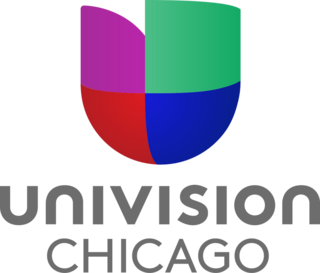
WSTR-TV, branded Star 64, is a television station in Cincinnati, Ohio, United States, affiliated with MyNetworkTV. It is owned by Deerfield Media, which maintains a local marketing agreement (LMA) with Sinclair Broadcast Group, owner of dual CBS/CW affiliate WKRC-TV, for the provision of advertising sales and other services. The two stations share studios on Highland Avenue in the Mount Auburn section of Cincinnati; WSTR's transmitter, Star Tower, is located in the city's College Hill neighborhood.
Superstation is a term in North American broadcasting that has several meanings. Commonly, a "superstation" is a form of distant signal, a broadcast television signal—usually a commercially licensed station—that is retransmitted via communications satellite or microwave relay to multichannel television providers over a broad area beyond its primary terrestrial signal range.

KTVT, branded CBS Texas, is a television station licensed to Fort Worth, Texas, United States, serving as the CBS outlet for the Dallas–Fort Worth metroplex. It is owned by the network's CBS News and Stations division alongside independent outlet KTXA. The two stations share primary studio facilities on Bridge Street east of downtown Fort Worth; KTVT operates a secondary studio and newsroom—which also houses advertising sales offices for the stations, as well as the Dallas bureau for CBS News—at the CBS Tower on North Central Expressway in Dallas. KTVT's transmitter is located in Cedar Hill, Texas.

KDAF is a television station licensed to Dallas, Texas, United States, serving as the Dallas–Fort Worth metroplex's outlet for The CW. It is owned and operated by network majority owner Nexstar Media Group, although it is not considered the company's flagship station. KDAF's studios are located off the John W. Carpenter Freeway in northwest Dallas, and its transmitter is located in Cedar Hill, Texas.

KTXA, branded as TXA 21, is an independent television station in Fort Worth, Texas, United States, serving the Dallas–Fort Worth metroplex. It is owned by the CBS News and Stations group alongside CBS outlet KTVT. The two stations share primary studio facilities on Bridge Street, east of downtown Fort Worth, and advertising sales offices at CBS Tower on North Central Expressway in Dallas. KTXA's transmitter is located in Cedar Hill, Texas.

KDFI, branded More 27, is a television station licensed to Dallas, Texas, United States, serving as the MyNetworkTV outlet for the Dallas–Fort Worth metroplex. It is owned and operated by Fox Television Stations alongside KDFW. The two stations share studios on North Griffin Street in downtown Dallas; KDFI's transmitter is located in Cedar Hill, Texas.

WFUT-DT is a television station licensed to Newark, New Jersey, United States, serving as the UniMás outlet for the New York City area. WFUT-DT is owned and operated by TelevisaUnivision alongside Paterson, New Jersey–licensed Univision station WXTV-DT. The stations share studios on Frank W. Burr Boulevard in Teaneck, New Jersey, and transmitter facilities at the Empire State Building in Midtown Manhattan. The programming of both stations and True Crime Network is simulcast to Long Island and southern Connecticut from WFTY-DT, broadcasting from Middle Island, New York.

WGBO-DT is a television station licensed to Joliet, Illinois, United States, serving as the Chicago-area outlet for the Spanish-language network Univision. It is owned and operated by TelevisaUnivision alongside Aurora-licensed UniMás station WXFT-DT. The two stations share studios at 541 North Fairbanks Court in the Streeterville neighborhood; WGBO-DT's transmitter is located atop the John Hancock Center.
WQHS-DT is a television station in Cleveland, Ohio, United States, broadcasting the Spanish-language networks Univision and UniMás. Owned and operated by TelevisaUnivision, it is the only full-power Spanish-language television station in the state of Ohio. WQHS-DT's studios and transmitter are located on West Ridgewood Drive in suburban Parma.
As of 2016, the Oklahoma City metropolitan area is the 41st-largest media market in the United States, as ranked by Nielsen Media Research, with 722,140 television households and 1.2 million people aged 12+. The following is a summary of broadcast and print media in Oklahoma City:
KPXG-TV is a television station licensed to Salem, Oregon, United States, broadcasting the Ion Television network to the Portland area. Owned and operated by the Ion Media subsidiary of the E. W. Scripps Company, the station has offices on Southwest Naito Parkway in downtown Portland, and its transmitter is located in the Sylvan-Highlands section of the city.
KAUT-TV is a television station in Oklahoma City, Oklahoma, United States, serving as the local outlet for The CW. It is owned and operated by the network's majority owner, Nexstar Media Group, alongside NBC affiliate KFOR-TV. The two stations share studios in Oklahoma City's McCourry Heights section; KAUT-TV's transmitter is located on the city's northeast side.
The Oklahoma Educational Television Authority (OETA) is a network of PBS member television stations serving the U.S. state of Oklahoma. The authority operates as a statutory corporation that holds the licenses for all of the PBS stations operating in the state; it is managed by an independent board of gubernatorial appointees, and university and education officials, which is linked to the executive branch of the Oklahoma state government through the Secretary of Education.

KOKH-TV is a television station in Oklahoma City, Oklahoma, United States, affiliated with the Fox network. It is owned by Sinclair Broadcast Group alongside independent station KOCB. The two stations share studios and transmitter facilities on East Wilshire Boulevard and 78th Street on the city's northeast side.

KOCB is an independent television station in Oklahoma City, Oklahoma, United States. It is owned by Sinclair Broadcast Group alongside Fox affiliate KOKH-TV. The two stations share studios and transmitter facilities on East Wilshire Boulevard and 78th Street on the city's northeast side.

Super TV was an American subscription television service operating in the Washington, D.C., and Baltimore metropolitan areas. that was owned by Subscription Television of Greater Washington, Inc. It was an early form of subscription television that was offered to prospective subscribers as either a standalone service to those that did not have access to cable television-originated premium services, or as an additional viewing alternative thereto.

ON TV was an American subscription television (STV) service that operated in eight markets between 1977 and 1985. Originally established by National Subscription Television, a joint venture of Oak Industries and Chartwell Communications, ON TV was part of a new breed of STV operations that broadcast premium programming—including movies, sporting events, and concerts—over an encrypted signal on a UHF television station and leased decoders to subscribing customers. At its peak in 1982, ON TV boasted more than 700,000 customers—more than half of them in Los Angeles, its most successful market. However, the rapidly expanding availability of cable television, coupled with a recession, caused the business to quickly lose subscribers at the same time that Oak Industries was experiencing severe financial difficulties. Between March 1983 and June 1985, all eight operations closed.

Spectrum was an American subscription television channel that was owned and operated by United Cable. Existing during the early 1980s, the service was available in the Chicago and Minneapolis–St. Paul metropolitan areas. It was also available in some areas of Alaska, such as Fairbanks.
Preview was an American subscription television service that launched in 1980. Like its competitors, such as ONTV and SelecTV, Preview was a scrambled UHF subscription channel requiring a special set-top box to decode the signal.
Satellite Television & Associated Resources (STAR) was an American operator of subscription television (STV) systems. Owned by businessman Byron Lasky and headquartered in Santa Monica, California, the company operated services under the "Star" and "Star TV" banners in markets including San Francisco, Boston, and New Orleans, which either broadcast in scrambled form on UHF television stations or via multipoint distribution service (MDS) microwave channels. With $12 million in liabilities, the company was forced into Chapter 7 bankruptcy in 1983 and its assets closed and sold to other companies.











